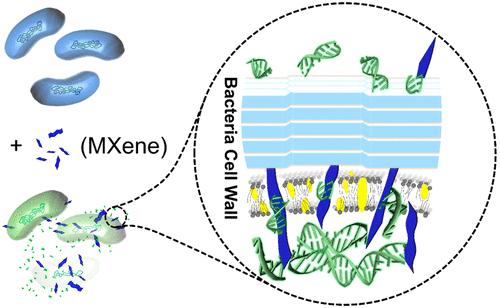当前位置:
X-MOL 学术
›
ACS Sustain. Chem. Eng.
›
论文详情
Our official English website, www.x-mol.net, welcomes your
feedback! (Note: you will need to create a separate account there.)
Antimicrobial Mode-of-Action of Colloidal Ti3C2Tx MXene Nanosheets
ACS Sustainable Chemistry & Engineering ( IF 7.1 ) Pub Date : 2018-10-15 00:00:00 , DOI: 10.1021/acssuschemeng.8b03823 Ahmad Arabi Shamsabadi 1 , Mohammad Sharifian Gh. 2 , Babak Anasori 3 , Masoud Soroush 1
ACS Sustainable Chemistry & Engineering ( IF 7.1 ) Pub Date : 2018-10-15 00:00:00 , DOI: 10.1021/acssuschemeng.8b03823 Ahmad Arabi Shamsabadi 1 , Mohammad Sharifian Gh. 2 , Babak Anasori 3 , Masoud Soroush 1
Affiliation

|
Antibacterial properties of two-dimensional (2D) nanomaterials are of great interest in fields such as environmental engineering, biomedical engineering, and medicine. Ti3C2Tx MXene, a novel 2D nanomaterial, has been reported to have excellent antibacterial activity against both Gram-negative and Gram-positive bacteria. This paper presents the first study aimed at determining the primary antibacterial mode-of-action of the MXene. We studied the antibacterial properties of MXene nanosheets with lateral sizes of 0.09, 0.35, 0.57, and 4.40 μm against Escherichia coli and Bacillus subtilis bacteria for 3 and 8 h in the dark. Quantitative analyses of bacteria species performed with complementary techniques, fluorescence imaging, and flow cytometry confirmed that the antibacterial activity of the MXene nanosheets is both size- and exposure-time-dependent. Smaller nanosheets showed higher antibacterial activities against both bacteria. For the first time, we applied broth microdilution assay to determine whether direct physical interactions between the MXene nanosheets and bacteria cells play a part in antibacterial properties of the nanosheets. Growth kinetics measurements evidently indicate that direct physical interactions between the sharp edges of the nanosheets and bacteria membrane surfaces play a crucial part in antibacterial properties of the nanosheets. The MXene nanosheets were found to damage the bacterial cells significantly in less than 3 h, leading to the release of bacteria DNA from the cytosol followed by bacteria cell dispersion. These results point to the great potential of MXene-based antibacterial products for water treatment, medical, and biomedical applications.
中文翻译:

胶体Ti 3 C 2 T x MXene纳米片的抗菌作用方式。
二维(2D)纳米材料的抗菌特性在环境工程,生物医学工程和医学等领域引起了极大的兴趣。据报道,Ti 3 C 2 T x MXene是一种新型的2D纳米材料,对革兰氏阴性菌和革兰氏阳性菌均具有出色的抗菌活性。本文提出了旨在确定MXene的主要抗菌作用方式的第一项研究。我们研究了侧向尺寸为0.09、0.35、0.57和4.40μm的MXene纳米片对大肠杆菌和枯草芽孢杆菌的抗菌特性细菌在黑暗中放置3和8小时。用互补技术,荧光成像和流式细胞仪进行的细菌种类定量分析证实,MXene纳米片的抗菌活性既依赖于大小,又依赖于暴露时间。较小的纳米片对两种细菌均显示较高的抗菌活性。首次,我们应用肉汤微稀释测定法来确定MXene纳米片和细菌细胞之间的直接物理相互作用是否在纳米片的抗菌特性中起作用。生长动力学测量结果显然表明,纳米片的锋利边缘与细菌膜表面之间的直接物理相互作用在纳米片的抗菌性能中起着至关重要的作用。发现MXene纳米片在不到3小时内显着破坏细菌细胞,导致细菌DNA从胞质溶胶中释放出来,随后细菌细胞分散。这些结果表明,基于MXene的抗菌产品在水处理,医学和生物医学应用中具有巨大的潜力。
更新日期:2018-10-15
中文翻译:

胶体Ti 3 C 2 T x MXene纳米片的抗菌作用方式。
二维(2D)纳米材料的抗菌特性在环境工程,生物医学工程和医学等领域引起了极大的兴趣。据报道,Ti 3 C 2 T x MXene是一种新型的2D纳米材料,对革兰氏阴性菌和革兰氏阳性菌均具有出色的抗菌活性。本文提出了旨在确定MXene的主要抗菌作用方式的第一项研究。我们研究了侧向尺寸为0.09、0.35、0.57和4.40μm的MXene纳米片对大肠杆菌和枯草芽孢杆菌的抗菌特性细菌在黑暗中放置3和8小时。用互补技术,荧光成像和流式细胞仪进行的细菌种类定量分析证实,MXene纳米片的抗菌活性既依赖于大小,又依赖于暴露时间。较小的纳米片对两种细菌均显示较高的抗菌活性。首次,我们应用肉汤微稀释测定法来确定MXene纳米片和细菌细胞之间的直接物理相互作用是否在纳米片的抗菌特性中起作用。生长动力学测量结果显然表明,纳米片的锋利边缘与细菌膜表面之间的直接物理相互作用在纳米片的抗菌性能中起着至关重要的作用。发现MXene纳米片在不到3小时内显着破坏细菌细胞,导致细菌DNA从胞质溶胶中释放出来,随后细菌细胞分散。这些结果表明,基于MXene的抗菌产品在水处理,医学和生物医学应用中具有巨大的潜力。









































 京公网安备 11010802027423号
京公网安备 11010802027423号